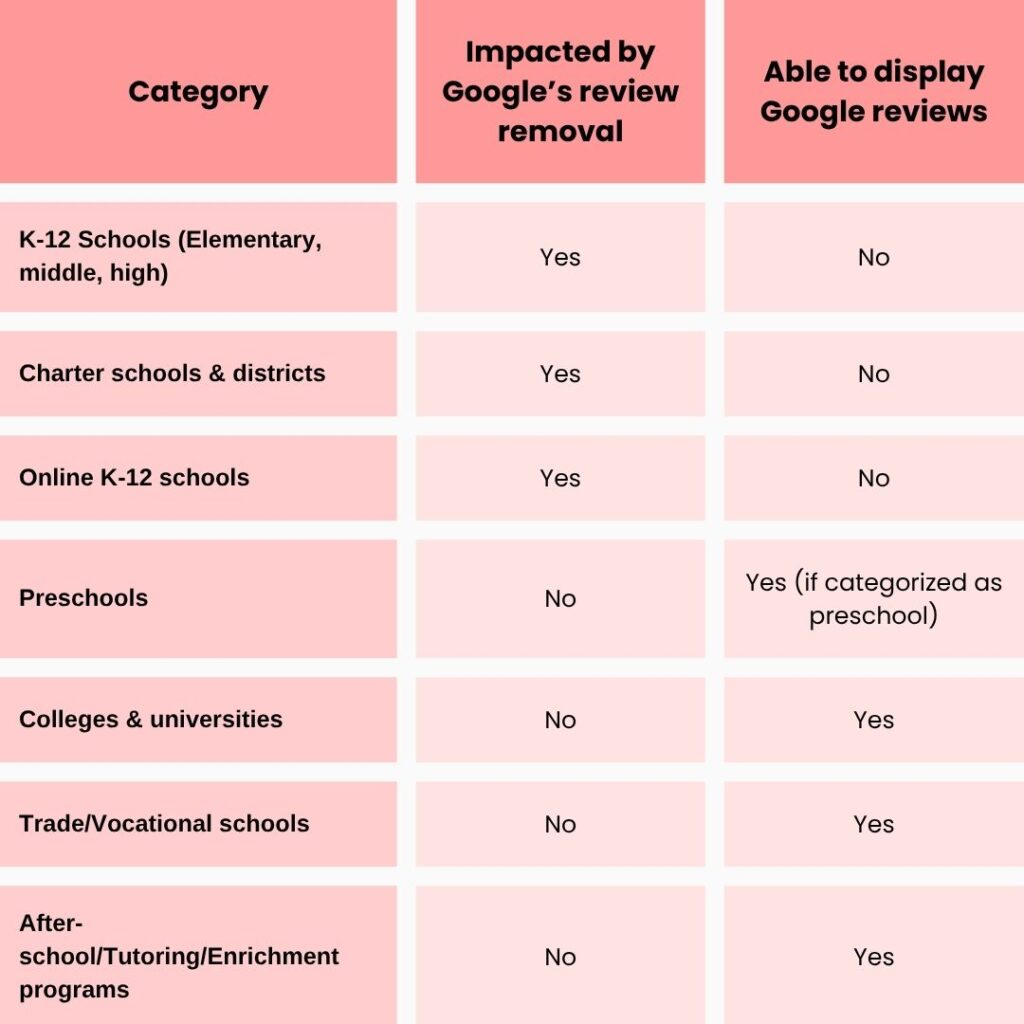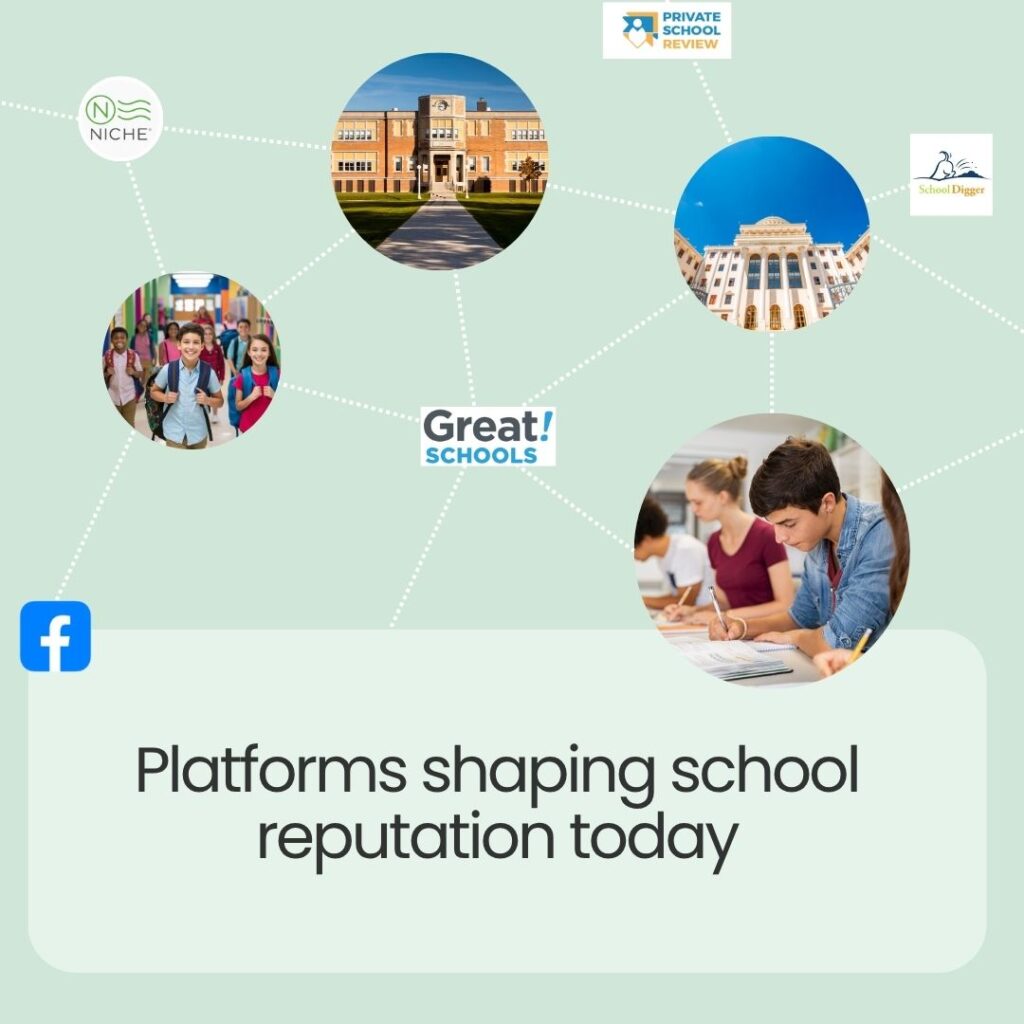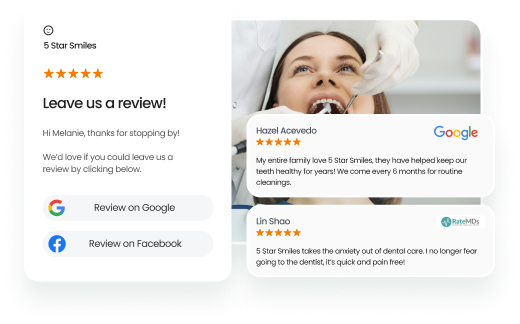In April 2025, Google wiped out reviews from over 136,000 K-12 school listings. If you relied on Google reviews as a key part of your school reputation management strategy to build trust with prospective families, you’re not alone in feeling blindsided.
But the reality is your school reputation didn’t disappear. Families haven’t stopped researching schools; they’ve simply turned to new sources.
In this blog, we’ll break down what happened, what it means for school marketing, and what steps you can take to rebuild trust and visibility even without Google reviews.
What happened: Google’s review policy shifted for schools
As of April 30, 2025, Google removed all star ratings and reviews from K-12 school listings, including those of public, private, charter, religious, and online schools.
This is an expansion of a policy that began in 2019, when Google started restricting reviews for early education providers to curb misinformation.
Let’s take a look at who’s impacted and who’s not:

FYI: Schools outside of the K-12 category can still use Google reviews to build their online visibility.
Now that we know what happened with Google reviews, you might be asking: Does your online school reputation still influence families’ choices? Spoiler: it does.
Why online reputation still drives school choice
Your online reputation continues to shape how families perceive leadership, values, safety, and the student experience. The data backs this up:
- 89% of parents say online reviews play a key role in school decisions
- 60% say feedback from other parents directly influenced their final choice
- 87% of all consumers read online reviews, and 79% trust them as much as personal recommendations
A strong online reputation also impacts several other critical areas:
- Enrollment: A school with a strong reputation consistently attracts more inquiries, stronger applicants, and higher enrollment yield.
- Faculty & staff recruitment: Educators want to join schools where leadership is respected, values are clear, and the community is engaged. A positive reputation makes it easier to attract and retain top staff.
- Fundraising: Donors and institutions back schools they trust. A respected brand enhances your chances of securing annual giving, grants, and board support.
- Crisis readiness: When issues arise, schools with established credibility get more benefit of the doubt and faster support.
So if families are still reading reviews, but Google isn’t hosting them anymore, where are they going? Let’s take a look at the platforms that are rising in influence.
Where families look now: 9 platforms that shape school reputation
People now turn to directories and other online platforms to compare schools. These sites play a growing role in how families understand a school’s culture, safety, academics, and leadership. Here’s a breakdown of the most influential platforms shaping school reputation today:
- Niche: Let students, alumni, and parents review both public and private schools, perfect if you want a sneak peek into day‑to‑day culture, academic vibes, and what peers really think.
- GreatSchools: Focuses on public schools, with parents, staff, and community members posting everything from test score snapshots to equity ratings and candid parent reviews.
- Facebook: Open to every type of school and reviewer, ideal for real‑time discussions, comments, and community chatter that you won’t find anywhere else.
- Reddit & local forums: No gatekeepers here, anyone can share hyper‑local experiences and unfiltered feedback on schools in your area.
- Private School Review: Built just for private schools, with students, alumni, and parents comparing everything from curriculum fit to admissions odds.
- Boarding School Review: All about boarding life, students, former boarders, and parents dish on U.S. and international boarding experiences.
- SchoolDigger: Public‑school fans, this one’s for you. Anyone can review, and you’ll get data‑driven comparisons, official rankings, and hard numbers.
- Yelp: Especially popular in urban and private‑school markets, Yelp’s community adds supplemental perspectives that often surface in select regions.
- Your School’s Website & Social: The one place you control completely, curated testimonials, parent‑focused stories, and your own messaging, front and centre.

Here’s something you can do today: grab control of your listings on all the sites families are using. A complete, accurate profile on each one makes you look more credible and shows up first when parents are scouring the web.
Collecting feedback has its legal risks, so before you start asking for testimonials, here’s what you need to know to stay on the right side of the law.
How to stay compliant while collecting reviews and testimonials
In education, building your reputation comes with real legal responsibilities, especially when students or families are involved. Here are the key rules every school should know:
- FERPA (Family Educational Rights and Privacy Act): Limits how schools share student info, names, photos, academic records, and behavior. Always get written consent for anything public-facing that features a student.
- COPPA (Children’s Online Privacy Protection Act): Restricts online data collection from children under 13. Parent consent is required for digital tools, surveys, or any online engagement involving younger students.
- PPRA (Protection of Pupil Rights Amendment): Applies to surveys involving personal beliefs, family background, mental health, or sensitive questions. Even informal or anonymous surveys must comply.
- State-Specific Laws (e.g., California’s SOPIPA, New York’s Ed Law 2-d): Some states add extra layers of regulation. If you’re using third-party tools, make sure any third-party tools you use meet both federal and local requirements.
Understanding the rules is one thing; putting them into action seamlessly is another. Let’s take a look at some hands‑on tips to keep you compliant and confident.
Best practices for privacy-safe reputation building
- Get written consent before publishing any testimonial, quote, or photo involving students or families
- Don’t include identifying information, names, photos, or classroom details without documented permission.
- Vet all platforms used for surveys, reviews, or content sharing for FERPA and COPPA compliance.
- Train staff to spot privacy risks before posting content, especially on social media or your school website.
Here’s the thing: when parents trust you with their info, they open up, share more feedback, and become your biggest advocates.
Now that you’ve mastered the compliance side, let’s talk about actively crafting your school’s story without leaning on Google reviews.
How to build school reputation without Google
Schools now have unprecedented opportunities to shape their reputation directly, using storytelling, third-party platforms, and strategic engagement. Here are a few tactics for a future-ready reputation strategy:
- Collect authentic stories: Use short videos, quotes, or written testimonials from parents, students, and alumni. Publish them on your website and social channels.
- Maintain third-party listings: Keep profiles on various third-party platforms accurate and complete. These still show up in search and influence decisions.
- Track sentiment across platforms: Monitor discussions on Facebook, Reddit, and forums. Use early feedback to spot trends and address concerns.
- Respond thoughtfully: Thoughtful, timely replies on public platforms show leadership and build trust.

Every story you share helps shape your school’s brand. The more authentic and personal your content, the more trust you build. As you roll out those content ideas, keep an eye on these four big trends that are reshaping how schools manage their reputations.
Four trends reshaping school reputation management in 2025
- AI-powered sentiment tools are becoming the norm: AI tools help schools monitor what’s being said on forums, reviews, and social media. This makes it easier to identify and address issues before they escalate.
- Families expect communication that reflects their values: People expect personalized communication. One-size-fits-all messaging no longer works. Schools need to understand what each community cares about and speak to it directly.
- Owned media takes the lead: Your website, social feeds, and newsletters are now your most trusted reputation channels.
- Privacy expectations are part of the brand: Families are increasingly conscious of how schools handle personal information. How you handle family and student data will directly impact your credibility.
That’s a lot to digest, so here are four immediate action steps you can take today to jump‑start your reputation strategy.
What can you do next to improve school reputation online?
Here are four steps you can take immediately to build a strong online reputation:
- Google yourself. See what families see first. Flag outdated listings, blank profiles, or mismatched information across Google, review sites, and social media.
- Update your listings. Update your profiles on key platforms like GreatSchools, Niche, Facebook, local directories, and your school’s own site.
- Collect authentic stories. Ask parents and alumni to share short testimonials. Use surveys, opt-in forms, or interviews, and always get clear consent. Publish them after getting consent.
- Track feedback patterns. Set up a simple system (manual or automated) to monitor what people are saying and respond to them promptly.
Of course, none of this sticks without the right toolkit. So here is what to look for in a reputation management platform.
Choosing the right school reputation management platform
The right tools make it easier to stay on top of what families are saying and to act quickly when it matters. These platforms should help you:
- Monitor conversations across 100+ sources, including social media, forums, review sites, and directories
- Enable privacy-safe feedback collection through structured surveys or forms
- Publish testimonials that reflect your school’s values and follow privacy guidelines
Birdeye Reviews AI, for example, is built to help schools manage reputation in a post-Google-review world clearly, safely, and at scale.
- Centralize mentions from third-party sites, forums, and social media into a single, unified dashboard
- Collect and publish feedback using opt-in, compliance-ready methods
- Get real-time insight into how your school is perceived, with alerts for issues before they escalate.
If you don’t know how your school is showing up online, start with a quick audit or sentiment scan. It’s the simplest way to identify your next step.
We’ve covered the what, why, how, and which. Now, let’s tie it all together and set you up for success.
Final take: Take control of the story families see online
Your school’s reputation lives in every story, share, and online mention. We’ve unpacked Google’s review shake‑up, explored the platforms families are using today, and laid out privacy‑safe ways to collect feedback. Now it’s your turn: take five minutes to Google your school and see what families see first. Then choose one platform to update or one parent story to share, and keep that momentum going. Own your school’s narrative and let every story reinforce the trust you’ve worked to build.
Ignoring your online reputation will seriously hurt your competitiveness.
Originally published









